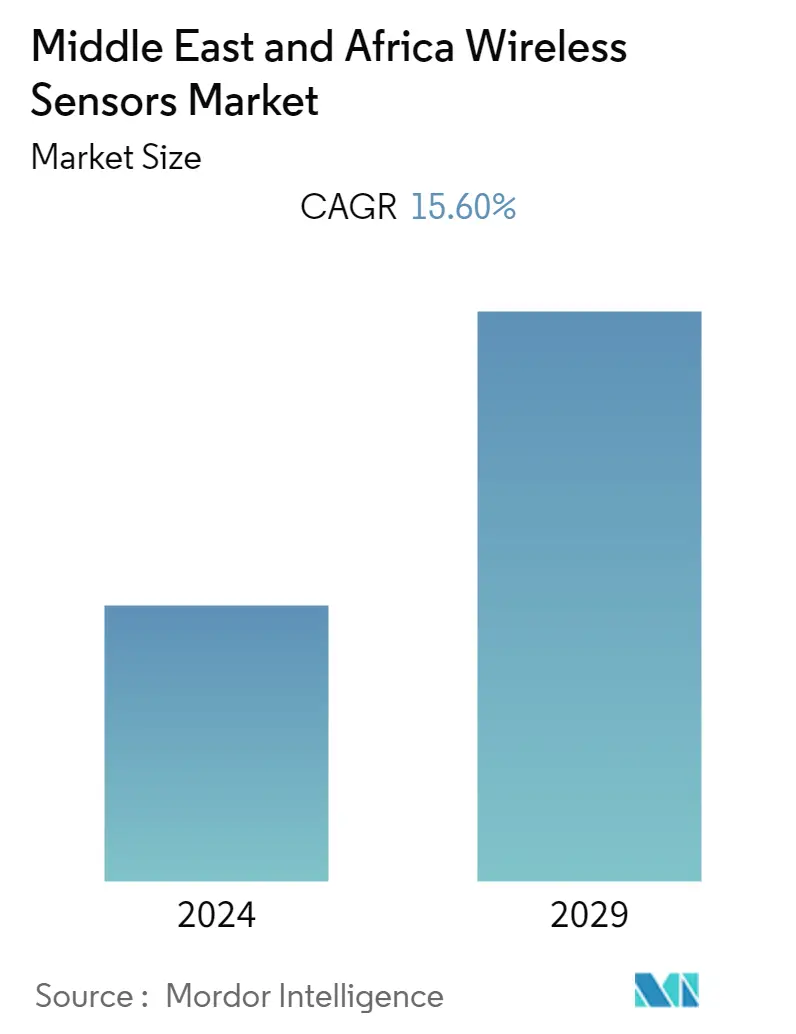Market Size of Middle East and Africa Wireless Sensors Industry

| Study Period | 2019 - 2029 |
| Base Year For Estimation | 2023 |
| Forecast Data Period | 2024 - 2029 |
| Historical Data Period | 2019 - 2022 |
| CAGR | 15.60 % |
| Market Concentration | Medium |
Major Players
*Disclaimer: Major Players sorted in no particular order |
MEA Sensors Market Analysis
The Middle East and African wireless sensor market are expected to register a CAGR of 15.6% during the forecast period (2021 - 2026). The growth in Industry 4.0 with the COVID-19 pandemic on the global scale has been acting as a catalyst that pushed the development of intelligent wireless sensors that help improve energy consumption with a high level of efficiency in the region. The growing range of pressure applications in industries contributes to developing single devices that can handle a range of pressures. Such devices are set to simplify product designs, accelerate time to market and reduce sensory inventory costs of industrial manufacturers.
- Africa is undergoing a technology boom, owing to the government's emphasis on telecommunications and the Chinese investment in the region, especially in emerging technologies. With the region's economy expected to be driven by South Africa, Kenya, and Morocco, consumer spending is also expected to increase further.
- Automotive and healthcare production substantiates the region's demand for wireless sensors. The area lacks the local production of aerospace and military equipment and other industrial control systems.
- According to Federal Ministry for Economic Affairs and Energy, around 1 million sensors are estimated to be the total demand for the Middle East region. Although there are no significant wireless sensor manufacturers in the region, such statistics indicate the scope for global manufacturers.
- The increasing military spending across the Middle East paves the way for technologies like drones/unmanned aerial vehicles (UAVs). In addition, the usage of wireless sensors in traditional fighter jets with high-end navigation systems is increasing significantly. The factors mentioned above are creating an exponential demand for wireless sensors in volumes as well.
- Additionally, the healthcare sector has witnessed a rise in wireless sensors, as these are helping care teams monitor patients in real-time. Wireless pushbuttons are serving as PERS devices in different senior care facilities. Humidity sensors are helping hospital facility managers to maintain healthy environmental conditions for patients.
- Moreover, wireless networks have many advantages, as they are easy to add or even easy to modify. If the room function or layout changes, it is possible to quickly reposition these sensors to get a stronger signal. For instance, they can be used for a modular retail or office space, with partition walls that change depending on use, or a temporary installation in a rented building.
MEA Sensors Industry Segmentation
The study characterizes the wireless sensors market based on the type of wireless sensors, the end-user industry, and the country. Wireless sensors are measurement tools for monitoring and recording the physical conditions of the environment. They are equipped with transmitters that convert signals from process control instruments into a radio transmission. These sensors have various applications in numerous sectors, such as automotive, healthcare, aerospace, etc. These have formed the part of the study in considering the end-user industry estimation. The scope of the study is currently focused on key regions, such as Saudi Arabia, United Arab Emirates, South Africa, etc. Further, to arrive at the overall market projections, the study analyzes the impact of COVID-19 and the investment scenario and other macro-economic factors.
| By Type | |
| Pressure Sensor | |
| Temperature Sensor | |
| Chemical and Gas Sensor | |
| Position and Proximity Sensor | |
| Other Types |
| By End-user Industry | |
| Automotive | |
| Healthcare | |
| Aerospace and Defense | |
| Energy and Power | |
| Food and Beverage | |
| Other End-user Industries |
| By Country | |
| Saudi Arabia | |
| United Arab Emirates (UAE) | |
| Africa (Nigeria, Kenya, Ghana) | |
| South Africa | |
| Rest of Middle East and Africa (Qatar, Bahrain, among others) |
Middle East and Africa Wireless Sensors Market Size Summary
The Middle East and Africa wireless sensors market is experiencing significant growth, driven by advancements in Industry 4.0 and the impact of the COVID-19 pandemic, which has accelerated the development of intelligent wireless sensors. These sensors are crucial for enhancing energy efficiency and are increasingly used in various industrial applications, such as pressure monitoring, which simplifies product designs and reduces costs. The region's technological boom, particularly in Africa, is fueled by government initiatives in telecommunications and foreign investments, notably from China, which are propelling the adoption of emerging technologies. Key economies like South Africa, Kenya, and Morocco are expected to lead this growth, with increased consumer spending further boosting demand. The automotive and healthcare sectors are significant contributors to the market, with wireless sensors playing a vital role in real-time patient monitoring and environmental condition management in healthcare facilities.
The market is characterized by a competitive landscape with multiple vendors offering wireless sensors for both domestic and international markets. Despite the lack of significant local manufacturers, the demand for wireless sensors is substantial, particularly in military applications where they are used in drones and advanced navigation systems. The South African manufacturing industry is also a key driver of market growth, with automation adoption increasing the need for wireless sensors. The food and beverage sector's reliance on automated controls for quality and consistency further fuels demand. Additionally, the retail industry's use of wireless sensor networks for hygienic production and distribution is contributing to market expansion. The Internet of Things (IoT) solutions market in Africa is growing, providing competitive advantages for wireless sensors. Major players in the market are focusing on product innovation and expanding their international customer base to enhance profitability.
Middle East and Africa Wireless Sensors Market Size - Table of Contents
-
1. MARKET INSIGHTS
-
1.1 Market Overview
-
1.2 Industry Value Chain Analysis
-
1.3 Industry Attractiveness - Porter's Five Forces Analysis
-
1.3.1 Bargaining Power of Suppliers
-
1.3.2 Bargaining Power of Consumers
-
1.3.3 Threat of New Entrants
-
1.3.4 Threat of Substitutes
-
1.3.5 Intensity of Competitive Rivalry
-
-
1.4 Technology Snapshot
-
1.5 Assessment of the Impact of COVID-19 on the market
-
-
2. MARKET SEGMENTATION
-
2.1 By Type
-
2.1.1 Pressure Sensor
-
2.1.2 Temperature Sensor
-
2.1.3 Chemical and Gas Sensor
-
2.1.4 Position and Proximity Sensor
-
2.1.5 Other Types
-
-
2.2 By End-user Industry
-
2.2.1 Automotive
-
2.2.2 Healthcare
-
2.2.3 Aerospace and Defense
-
2.2.4 Energy and Power
-
2.2.5 Food and Beverage
-
2.2.6 Other End-user Industries
-
-
2.3 By Country
-
2.3.1 Saudi Arabia
-
2.3.2 United Arab Emirates (UAE)
-
2.3.3 Africa (Nigeria, Kenya, Ghana)
-
2.3.4 South Africa
-
2.3.5 Rest of Middle East and Africa (Qatar, Bahrain, among others)
-
-
Middle East and Africa Wireless Sensors Market Size FAQs
What is the current Middle East and Africa Wireless Sensors Market size?
The Middle East and Africa Wireless Sensors Market is projected to register a CAGR of 15.60% during the forecast period (2024-2029)
Who are the key players in Middle East and Africa Wireless Sensors Market?
Honeywell International Inc., Emerson Electric Co., Texas Instruments Inc., ABB Ltd. and Pasco Scientific are the major companies operating in the Middle East and Africa Wireless Sensors Market.

